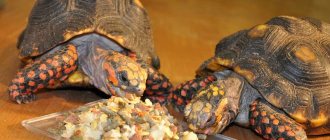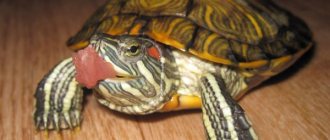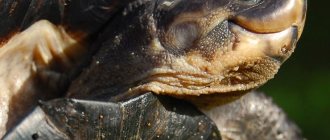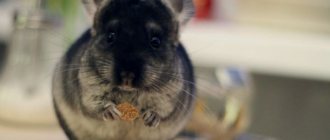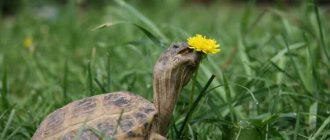- Wild animals
- >>
- Reptiles
The red-eared slider is the most popular pet amphibian in the world, which is why it became the best-selling turtle at the end of the 20th century.
This species is native to the southern United States and northern Mexico. However, it gradually began to spread to other regions due to people refusing to keep it as a pet and throwing it into local water bodies. Invasion and occupation of territories caused by careless human activities has led to problems with the fauna of many countries, as the red-eared slider displaces native species. The ruby is included in the list published by the IUCN of the 100 most invasive species.
Origin of the species and description
Photo: Red-eared turtle
Fossils indicate that turtles first appeared on earth about 200 million years ago, during the Upper Triassic period. The first known turtle was Proganochelys quenstedli. It had a fully developed shell, skull-like skull and beak. But, Proganochelys had several primitive features that modern turtles do not have.
By the mid-Jurassic period, turtles had split into two main groups: those with arched necks (pleurodire) and those with side necks (cryptodires). Modern side-necked turtles are found only in the southern hemisphere and move their heads to the side under the shell. Arch-neck turtles retract their heads in an S shape. Scutemy was one of the first arch-neck turtles.
Video: Red-eared slider
The red-eared or yellow-bellied turtle (Trachemys scripta) is a freshwater turtle belonging to the family Emydidae. It gets its name from the small red stripe around its ears and its ability to quickly glide off rocks and logs into the water. This species was previously known as Trost's turtle after American herpetologist Gerard Trost. Trachemys scripta troostii is now the scientific name of another subspecies, the Cumberland turtle.
The redfish belongs to the order Testudines, which contains about 250 species.
The species Trachemys scripta itself contains three subspecies:
- Ts elegans (red-eared);
- T.s. Scripta (yellow-bellied);
- Ts troostii (Cumberland).
The first known literary mention of redears dates back to 1553. When P. Cieza de Leone described them in the book “Chronicles of Peru”.
Dangerous products
We now know what different types of turtles eat. But still, some owners share food with their pets that may be dangerous for the animals.
The following foods should never be given to any turtles:
- Beef, pork, lamb and their derivatives (sausage, frankfurters, pate, minced meat),
- Cheeses and dairy products,
- Bakery products,
- Potato,
- Corn,
- Citruses,
- Feed intended for other animals.
All of these foods can impair the well-being and health of pet reptiles. Dangerous plants for reptiles include azaleas, dieffenbachias, oleanders, elodeas and euphorbias .
Appearance and features
Photo: Animal red-eared turtle
The length of the shell of this type of turtle can reach 40 cm, but the average length ranges from 12.5 to 28 cm. Females are usually larger than males. Their shell is divided into two sections: the upper or dorsal carapace (carapace) + the lower, abdominal (plastron).
The upper shell consists of:
- vertebral shields, which form the central elevated part;
- pleural shields located around the vertebral shields;
- edge shields.
The scutes are bony keratin elements. The carapace is oval and flattened (especially in men). The color of the shell changes depending on the age of the turtle. The carapace usually has a dark green background with light or dark markings. In young or newly hatched specimens, this is the color of the green foliage, which gradually darkens in mature specimens. Until it turns dark green and then changes shade between brown and olive green.
The plastron is always light yellow with dark, paired, irregular markings in the center of the shields. The head, legs and tail are green with thin, irregularly shaped yellow lines. The entire shell is covered with stripes and markings that help in camouflage.
Interesting fact! The animal is a poikilotherm, that is, it cannot independently regulate its body temperature and is completely dependent on the temperature of the environment. For this reason, they need to sunbathe frequently to stay warm and maintain their body temperature.
Turtles have a complete skeletal system with partially webbed feet that help them swim. The red stripe on each side of the head distinguished the red-eared slider from other species and became part of the name, as the stripe is located behind the eyes where their (outer) ears would be.
These stripes may lose their color over time. Some individuals may have a small marking of the same color on the top of the head. In addition, they do not have a visible outer ear or external auditory canal. Instead, there is a middle ear, completely covered with a cartilaginous tympanic disc.
Caring for your turtle
The first thing you should pay attention to when purchasing a pet is its appearance and size. A turtle that is under 5 cm in size at the time of purchase will be very difficult to raise.
At this age, small individuals are susceptible to various infections and diseases. This is how natural selection takes place. Therefore, a turtle 5–7 cm in size will be the best choice when purchasing.
You should also carefully examine the color of the shell. The claws and tail must be intact. The skin looks healthy and the eyes shine. After the pet is in the aquarium, watch how it swims. A healthy turtle should swim smoothly, without leaning in different directions.
Healthy turtle
Features of treatment
After purchasing a pet and moving it into an aquarium, it may go through an adaptation period. Typically it will take 2 to 5 days. At this time, the animal becomes a little inhibited, or, conversely, very active. There is no need to panic and pick up the animal. Give him peace and time to adapt to new conditions. After a while, the turtle will get used to the new environment and become calmer.
When trying to pick up a turtle, do it very carefully and always with both hands. Not all representatives are willing to make contact. Some may flounder, hiss, and defecate in fear. The shell becomes slippery in water; keep this fact in mind when removing your pet from the aquarium.
After you hold the turtle in your hands, be sure to wash them with soap. Despite being kept clean, turtles are often carriers of salmonellosis. To avoid the spread of infection, you must always monitor the condition of the aquarium and the quality of the food.
Where does the red-eared turtle live?
Photo: Little red-eared turtle
Habitats are in the Mississippi River and Gulf of Mexico, as well as in the warm climate of the southeastern United States. Their home territories range from southeastern Colorado to Virginia and Florida. In the wild, red-eared turtles inhabit areas with sources of calm, warm water: ponds, lakes, swamps, streams and slow-moving rivers.
They live where they can easily get out of the water, climb onto rocks or tree trunks to warm themselves in the sun. They often sunbathe in a group or even on each other. These turtles in the wild always stay close to water unless they are searching for new habitat or laying eggs.
Due to their popularity as pets, red whales have been released or escaped into the wild in many parts of the world. Wild populations are now found in Australia, Europe, Great Britain, South Africa, the Caribbean, Israel, Bahrain, the Mariana Islands, Guam, and Southeast and Far East Asia.
An invasive species has a negative impact on the ecosystems it occupies because it has certain advantages over native inhabitants, such as a lower age at maturity and higher fertility rates. They transmit diseases and displace other turtle species with which they compete for food and breeding space.
Food in winter
The change of season is reflected in nutrition. In the summer, feed herbivores and omnivores with greens, vegetables and fruits. Turtles eat frequently and have small portions. In cold weather, reptiles are content with frozen foods and hay; they eat rarely, but in large quantities.
You can plant plants in pots, this will provide the turtles with fresh greens to eat in the winter. Propagate plants such as duckweed or hornwort so that turtles can be fed aquarium flora continuously. To do this, you will need to purchase a separate aquarium and properly care for the plants.
What does the red-eared slider eat?
Photo: Red-eared turtle boy
The red-eared slider has an omnivorous diet. They need abundant aquatic vegetation, as this is the main food of adults. Turtles do not have teeth, but instead have jagged and sharp horny ridges on their upper and lower jaws.
The animal's menu includes:
- aquatic insects;
- worms;
- crickets;
- snails;
- small fish,
- frog eggs,
- tadpoles,
- water snakes,
- various algae.
Adults tend to be more herbivorous than juveniles. When young, the red-eared turtle is a predator, feeding on insects, worms, tadpoles, small fish and even carrion. Adults are more inclined to a vegetarian diet, but do not refuse meat if they can get it.
Interesting fact! Sex in turtles is determined during the embryogenesis phase and depends on the incubation temperature. These reptiles lack sex chromosomes that determine sex. Eggs that are incubated at 22 - 27°C become only males, and eggs that are incubated at higher temperatures become females.
These reptiles are highly adaptable to their environment and can adapt to anything from brackish waters to man-made canals and urban ponds. The red-eared slider can wander away from water and survive cold winters. Once available habitat is found, the species quickly colonizes the new area.
What is not recommended to include in the diet
The most dangerous foods for river turtles are from the human table, as well as food consumed by pets.
Never feed your reptiles the following types of food:
- vegetables;
- fruits;
- too fatty varieties of fish and meat.
You should also be especially careful when choosing insects and plants. Many types of them can be poisonous, while others can interfere with the normal process of calcium absorption or cause iodine deficiency.
If you follow all the necessary recommendations and nutritional tips, your pet will always be in a healthy state of mind. For him, the most important thing is a rich and balanced diet, and you can think through it yourself, the main thing is to first study its features.
Features of character and lifestyle
Photo: Large red-eared turtle
Red-eared turtles live from 20 to 30 years, but can live more than 40 years. The quality of their habitat has a strong influence on life expectancy and well-being. Turtles spend almost all their time in the water, but since they are cold-blooded reptiles, they leave the water to sunbathe in order to regulate their body temperature. They absorb heat more efficiently when their limbs are extended outward.
Red whales do not hibernate, but plunge into a kind of suspended animation. When turtles become less active, they sometimes come to the surface for food or air. In the wild, turtles spend the winter at the bottom of ponds or shallow lakes. They generally become inactive in October when temperatures drop below 10°C.
During this time, turtles enter a state of stupor, during which they do not eat or defecate, remain almost motionless, and their breathing rate drops. Individuals are most often found underwater, but have also been found under rocks, in hollow stumps and sloping banks. In warmer climates, they can become active in winter and come to the surface to swim. When the temperature begins to drop, they quickly return to a state of stupor.
On a note! Red-eared turtles are caught for food from early March to late April.
During brumation, the species can survive anaerobically (without air) for several weeks. The turtles' metabolic rate drops sharply during this time, and heart rate and cardiac output are reduced by 80% to minimize energy requirements.
Behavior
These reptiles are active during the day and sleep at night. To sleep, they go down to the bottom of the reservoir in which they live. During the day they prefer dry land to warm themselves. They are capable of moving several kilometers away from a body of water. They cannot stay in the water all the time - they need air to breathe, so the animals often float to the surface. They can survive without oxygen for about two hours. With low activity, the need for it disappears completely, since anaerobic respiration is activated.
These turtles swim well and quickly. When a threat is detected, they tend to hide in the grass or coastal mud. On land, the reptile also moves quite quickly.
Social structure and reproduction
Photo: Red-eared turtle
Male turtles reach sexual maturity when their shell is 10 cm in diameter, and female turtles are mature when their shell is 15 cm in diameter. Both males and females are ready to reproduce at the age of five to six years. The male is smaller than the female, although this parameter is sometimes difficult to apply since the individuals being compared may be of different ages.
Courtship and mating take place underwater from March to July. During courtship, the male swims around the female, directing his pheromones towards her. The female begins to swim towards the male and, if she is receptive, sinks to the bottom to mate. Courtship lasts about 45 minutes, but mating takes only 10 minutes.
The female lays between two and 30 eggs depending on body size and other factors. Moreover, one individual can lay up to five clutches in one year, with time intervals of 12-36 days.
Interesting fact! Fertilization of the egg occurs during oviposition. This process allows fertilized eggs to be laid in the next season, since the sperm remains viable and available in the female’s body even in the absence of mating.
In the last weeks of pregnancy, the female spends less time in the water and looks for a suitable place to lay eggs. She digs a hole-nest using her hind legs.
Incubation takes from 59 to 112 days. The offspring remain inside the eggshell for two days after hatching. During the first days, the cubs still feed from the yolk sac, the reserve of which still remains in the egg. The area through which the yolk is absorbed must heal on its own before the turtles can swim. The time between hatching and immersion in water is 21 days.
Reviews
German Leonidovich, 34 years old, Kharkov
I work in a clinic and periodically I get so tired of the noise and bustle that I come home to relax. Unfortunately, I am allergic to wool, so I got myself a river turtle as a pet. What can I say: calm, flexible, quite intelligent. I can’t assure that this is a girl (my friends brought her to me), but for some reason I wanted to name her Dusya. Sometimes we are very close and spend time together, watching TV, and I stroke her shell. And, by the way, the river turtle turned out to be not a river turtle at all; it spends most of its time on land. In short, this is the most docile pet, quiet, calm, and does not eat very much. Dusya is the only turtle so far, but not the last, soon I want to finally find out her gender and find her a boyfriend or girlfriend.
Daria Viktorova, 21 years old, Solnechnogorsk
My father brought me a river turtle when he was returning from a business trip in his car. According to dad, she ran through his path. He was afraid of crushing her and braked in time, got out, took her in his arms and decided to give her to me. Then Krosh was very small, but in 7 years he grew up and became quite a large individual. He doesn’t really like water, and if I put him in the bath and try to move away, Krosh tries to get out, he asks to come to me. There was a time when it seemed to me that he was sick. No matter what I gave him to eat, he refused. It even seemed to me that his shell would soon completely fall off, because he was becoming softer and softer. It turns out that he simply did not have enough food fortified with calcium. Since then, I periodically pamper my pet with snails and shrimp.
Danila Arsenievich, 54 years old, Kislovodsk
My wife and I spend most of our time in the city, but on weekends we come to the dacha to visit our turtle Masha. Our grandchildren caught it for us not far from the river. Since then, Masha lives most of the time with a neighbor, and when we arrive at the dacha, we take her to our place. In summer and spring we release it onto the lawn. When we were young, we kept both hamsters and parrots - everything was not the same, they either made noise or smelled. But with our Masha there are no such worries.
Natural enemies of the red-eared slider
Photo: Adult red-eared turtle
Due to its size, bite and thickness of shell, an adult red-eared turtle should not be afraid of predators, of course, unless there are alligators or crocodiles nearby. She can retract her head and limbs into her shell when threatened. In addition, red whales monitor predators and seek refuge in the water at the first sign of danger.
However, this does not apply to juveniles, which are preyed upon by a variety of predators, including:
- raccoons;
- skunks;
- foxes;
- wading birds;
- storks.
Raccoon, skunk and fox also steal eggs from this turtle species. Juveniles have unusual defenses against predatory fish. When swallowed whole, they hold their breath and chew the mucous membrane inside the fish until the fish regurgitates them. The bright colors of small predators warn large fish to avoid them.
In their home range, red-eared turtles occupy an important ecological niche both as food and as a predator. Outside their habitats, they fill the same types of niches and become an important food source for predators in urban and suburban areas.
Due to their adaptability, red-eared turtles are the predominant turtle species in urban environments. Most parks in many cities in the United States have thriving colonies of red-eared turtles for people to enjoy.
How often should you feed
Juveniles must eat frequently and need to be fed every day. But older reptiles are fed less often - once every two or three days. Typically, amphibians can be given chicken or beef liver once a week.
It is worth noting! Additionally feed the turtles with special dry food, which contains a high level of beneficial components and nutrients. But these reptiles most of all require calcium, which can only be absorbed under the influence of lamps that replace sunlight.
Sometimes you can add plant foods. You can do this once a week. Among the vegetation, these individuals can readily eat algae, duckweed, dandelions, and vegetation that grows near water bodies.

